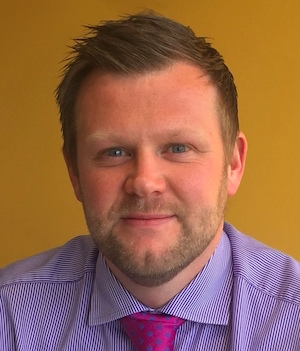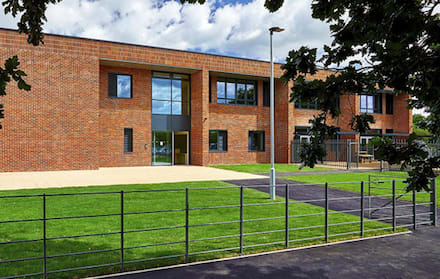While some firms struggle to quantify a return on digital, that’s not the case at Morgan Sindall Construction, where design management and BIM director Lee Ramsey has seen some very healthy savings. He reveals the sums to Denise Chevin
You’ve led on Morgan Sindall Construction’s digital information management since 2016 – what does the role entail?
My job is to ensure everything is going in the right direction with the company’s digital construction strategy – so I look after the people, process and technology for all the digital construction aspects for the business.
I’ve got a regional team that I lead. Each of our company regions has a regional implementation manager, and each region has got a head of design management as well. I report to the national MD for sign off of the digital construction strategy.
There are about 70 design managers, but it’s very decentralised as we like everyone to have the knowledge to do their job quite independently.
Why ‘digital information management’ rather than BIM management?
We call it digital information management (DigIM) because it brings together many related things under one banner, from digital construction to digital twinning. We’ve found that sometimes the term BIM can be a barrier, because people think it’s all about modelling, which it’s not, so we’re trying to wrap it in one term.
There’s real synergy between design management and digital. As a contractor, we talk about digital construction. But when we talk to a client, it’s all about the handover and running the building, and that’s where digital information management comes in.
What’s your main goal at Morgan Sindall Construction?
We want to take advantage of digital ways of working to increase our productivity, improve outcomes, and enable our teams to grow sustainably.
One of our key targets is to reduce project times by optimising collaboration, and thus we can increase client satisfaction by delivering an exceptional built environment.
Every client is different, so we want to be responsive to their needs, and understand what best value information means to each of them, understand their challenges and needs, and respond – rather than saying we want to have every project in this format, in this way, by this date.
Has this lead to significant improvements in productivity? It can be hard to demonstrate return on investment with BIM.
Yes, it has. Of the £525m worth of projects that we’ve done digitally, we’ve seen 66% fewer variations, and we’ve also seen that 26% of these digital projects are ahead of programme, compared to ones not running digitally. So there’s a direct correlation between building virtually before building for real.
Our analysis has shown that on average on a typical project a clash costs £8,500, if that clash is realised. Typically on our projects when we’ve done the analysis, there are 86 clashes on a project. Some of them would be captured by traditional methods, but let’s say 30% might slip through the net of a human checking process. That could still be a substantial amount.

We’ve found that sometimes the term BIM can be a barrier, because people think it’s all about modelling, which it’s not, so we’re trying to wrap it in one term.– Lee Ramsey, Morgan Sindall Construction
Are all your projects done digitally now?
The vast majority are, and even when a client might not ask for the project to be a BIM project, we will still deliver in a digital way because we can see the value and the benefits. We’ve operated this way since 2016, when I became in charge of digital construction.
To put that into perspective, our annual turnover is £750m and the £525m in projects we’ve undertaken digitally reflects projects that we’ve finished since 2016 – a significant figure. There are currently about 50 more digital projects we’re working on.
Do you always hand over a digital asset?
If there’s an asset data requirement, we will always hand over asset data. Asset data is a fundamental requirement for Level 2 or BIM in accordance with ISO 19650. We’ve delivered 42 projects to date with asset data, mainly in the public sector.
Although they’ve not been mandated by theg overnment to use BIM, we show them the value of working digitally, and the benefits of asset data and that persuades them it’s a good idea.
As well as my work at Morgan Sindall Construction, I have a digital role with the National Association of Construction Frameworks (NACF), which is an organisation that helps shape the future of local government construction. In a recent survey we carried out, we found that the key obstacles to implementing digital construction were cultural, because so much of what we do relates to facilities management and bringing those people in at the start of the project, because that’s where the biggest value is. So we want them to understand those key decisions at the front end.
Do you think BIM is still seen as too difficult for many clients?
We’ve definitely found the complexity to be an obstacle. Sometimes the term BIM is a barrier. So we’re trying to get this simplification to reduce cost and time.
A lot of the problem can be to do with information overload. We’ve spoken to clients who have been under the impression they need to get some particular software, but didn’t appreciate that the process and the people are really the starting point.
I think it’s all about the practical implementation of BIM. It isn’t hard, it’s just about getting the right information at the right time, to the right person, to the right quality. It’s as simple as that.
All we’re doing is putting a bit more structure around a process, and giving people some better tools. It’s just about doing things in a more structured, more effective manner, with better tools. It’s really no different to what clients would expect. Really, we should do it on every project: that should be the client’s expectation.
Is there also a perception that it contributes to cost, and that clients don’t want to pay contractors to invest in tech?
I don’t see BIM level 2 adding much cost now. A lot of the things, like designing in 3D, are pretty much business as usual for our design teams.
But although the cost premium from the design team has come down, the key is getting the right level of brief. More information doesn’t mean a better outcome necessarily. Designing everything to the nth degree, modelling the screws in the door, doesn’t necessarily represent best value. It’s about understanding where the risk is, and what information is going to add value. And if we have a reasonable, value-driven brief, there’s no reason why the project shouldn’t be similar in price to a traditional project. There might be a little bit more checking, in terms of the data, but that cost is minimal in the scheme of things.

Morgan Sindall recently completed the Stoneham Park Primary Academy in Hampshire: it was awarded via the Southern Construction Framework
Tell us a bit more about your work with the National Association of Construction Frameworks.
I’ve been the lead for digital information management for the association for about a year now. We’re made up of national and regional frameworks that work together for local government associations – there are 10 members, including Southern Construction Framework, Scape, South and Mid Wales, Constructing West Midlands and the North West Construction Hub, to name just some. In total the group delivers £1.5bn of construction work a year.
As part of my role, I set out a detailed research programme to understand where clients are, in terms of stages, to help generate the DigIM strategy for the group. It’s a way of sharing best practice across the group.
We carried out that survey I mentioned last December, and out of that we realised how key facilities management is to the whole process. So we created a facilities management group, to really try to combine organisational information requirements, and what they need in terms of asset information requirements.
As a result, we’re now working with facilities management experts from local authorities who manage estates, and getting to understand what 3D modelling information they need to run their estates better.
We’re looking to create a menu of benefits and outcomes and a toolkit for the group, so when people want to brief on a project at the beginning, they can understand what outcomes and benefits they want and can make better selection choices. By benchmarking with measures and metrics, clients will have a value proposition to consider, rather than a purely technical choice.
[View the toolkit here: https://construction.morgansindall.com/news/digital-construction-toolkit-launch-%E2%80%93-operation-first]
More generally, is there anything that’s proving a real obstacle to further BIM progress?
The fragmented nature of technology can sometimes be a challenge. There are more and more products coming out that are very specialised, and then the problem is integrating all those things together. The interoperability between them can be a challenge.
What is currently driving technological change in the sector? And do you think the current economic climate will encourage people to drive productivity rather than cut costs and investment?
We’ve seen how cloud working has helped projects. We’ve seen that even though these are very challenging times, this is a time to look at doing things in a new way. Challenges lead to innovation. This is the time when you need to invest, to improve productivity, and to do things in a better way.
We’ve been looking to increase the roll out of BIM 360. With Covid, we’ve found that people working on projects that have been using BIM 360 can work better remotely, share information more quickly, and need less time for uploading and downloading.
Meetings also take less time as well on Microsoft Teams, because the information is being managed better – because people are better prepared, they’re already more engaged with the information before the meeting. So we’ve been seeing potential savings of 20% on time in the pre-construction stage thanks to things like BIM 360.
And by working digitally, it’s easier to identify change, and identify issues as well.
People will invest to save. For our organisation, we’re looking to where we can improve, to make sure that we become better and more effective.
Where to next?
For me, my role is more about change management now, it’s about adapting and identifying new ways to do better things, not just doing things better.
We’re looking at things like generative design and artificial intelligence, so we’ve been trialling Autodesk BIM 360 design and coordinate, where models can be federated automatically in the cloud, and clash detection results can be instantaneous. What would normally take three weeks now takes just minutes.
Generative design tools are going to be really interesting. Essentially, you teach a computer to do things, and set what ‘good’ looks like, and then the computer will work out all the possible permutations, and present you with the various options. Something that could have taken you 12 weeks can be done in minutes.
And it becomes very analytical, that’s where artificial intelligence is good. It’s very good with statistical factors, and return on investment, costing aspects and time etc. And it’s very good at reconciling human factors.
Revit 2021 has some inbuilt generative design features currently [too], and we are actively exploring the use of generative design, and looking for opportunities in our sectors. It takes quite a bit of time though, so we’re trying to reduce that and focus on the time where it’s going to add value.















